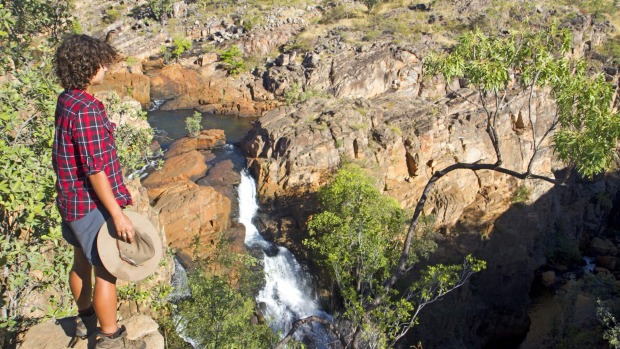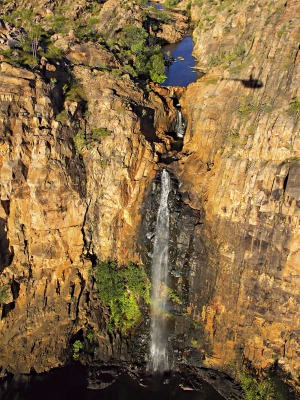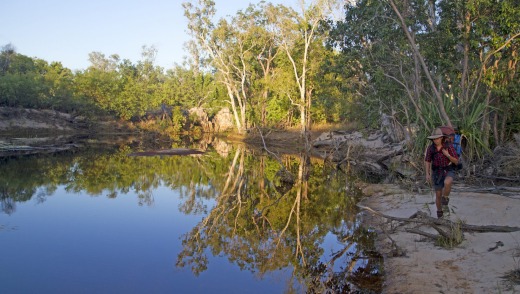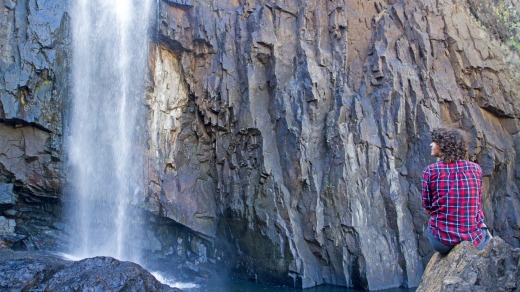
Three steps from my bed, the river has ballooned into a virtual billabong. Lilies bloom in purple glory around its banks and goanna tracks lead through the sand to the water. As evening approaches, the river settles to be as still as a painting.
We're at a place called Sandy Camp and it's everything the name on the tin suggests – a soft bed of sand beside the Edith River that's home to one of the Northern Territory's most idyllic campsites.
It's also a camp that's exclusive to bushwalkers because it can be accessed only by hiking the 58-kilometre Jatbula Trail through Nitmiluk National Park. It's our final night on the trail and tomorrow we have 14 kilometres and three swims still ahead. It's about as good as it gets on foot.

Our journey on the Jatbula Trail began four days earlier, at the mouth of Katherine Gorge. As an armada of tourist canoes headed into the gorge, we were walking away from it, stepping through the savannah woodland that characterises so much of the Top End.
Running north from the gorge, the Jatbula Trail follows a course used by generations of Jawoyn people, tracing the line of the Arnhem Land Escarpment to Leliyn (Edith Falls). It's a trail that lives in the shadow of the famed Larapinta Trail out of Alice Springs, but has its own very distinctive appeals.
The trail's ascending scale of campsite beauty culminates at Sandy Camp.
As Katherine Gorge falls behind us, the trail weaves between small rocky peaks. Fallen billygoat plums – a native fruit said to have more than 20 times the vitamin C of an orange – litter the track and the midday heat on the open savannah is intense.

Within an hour, however, the trail turns into a break in the escarpment, where a large pool, Northern Rockhole, lies limpid beneath the cliffs.
If the Jatbula Trail has a theme, it is this: hot walking and cool swimming. Water is its defining feature. You think about it during the blazing-hot hours on foot, and you luxuriate in it each afternoon, with every campsite set beside a cooling (and crocodile-free) stream or pool.
From Northern Rockhole, the trail ascends slowly through the escarpment, rising onto the "stone country" that so typifies Arnhem Land. Outcrops of sandstone run like welts through the dry land, and ancient rock art peeps from beneath overhangs and boulders. All around us are the orange flares of the woollybutt flowers – in the trees, where the flowers' appearance heralds the arrival of the dry season, and underfoot, where they've been shredded and tossed by t red-tailed black cockatoos.

Days aren't long on the Jatbula Trail – campsites are typically 10 or 11 kilometres apart – and by mid-afternoon we're at our first camp beside Biddlecombe Cascades. Here, a creek falls towards the plain in a series of surges, creating a range of pools as it goes. The afternoon passes with cold water pouring over my shoulders.
We sleep out beneath mosquito nets, savouring the fresh night air after the heat of the day. The sound of the cascades drifts through camp, and the near-full moon is like a reading lamp swivelling across the sky.
Each day we rise before dawn and walk early, mitigating the heat. For long periods, the trail stays near the escarpment edge, cutting through savannah woodland that is at once beautiful and nondescript, with the orangey-pink trunks of salmon gums beaming in the sunlight.
For 11 kilometres there's not a sign of water, until the trail descends to Crystal Falls, where a stream rushes through a gorge cut deep into the plateau. It's 1pm – the full heat of the day – and we are done. This is camp and there are hours to idle away in the cascades.
By morning the creek resembles a cauldron, as steam pipes from its surface into the chill of the dawn air. As we splash across in our bare feet, we're setting off into a day with a familiar theme – the siren call of water – but also one with a difference.
After two hours of walking, we come to the top of a gorge sliced into the escarpment. Known as the Amphitheatre, it's one of Nitmiluk National Park's prime rock-art sites and can only be reached on the Jatbula Trail.
A set of metal stairs descends into the Amphitheatre, where a stream meanders through monsoon rainforest. Butterflies drift about and ferns feather down from the shaded walls. It's a cool natural shelter in a hot land, almost like a pocket of temperate Australia inserted into the Top End.
Along the base of the cliffs striped with ochre deposits, a line of rock art depicts a trio of emus and human figures, including a woman dressed in her finery to attract a man.
Each day the setting for the campsites gets gradually more impressive and dramatic. This night, one hour of walking beyond the Amphitheatre, we camp at the head of 17 Mile Falls, where 17 Mile Creek plunges over 30 metres of sheer cliffs before meandering out of sight in a dark line of greenery.
From the cliff edge, a few metres from camp, it's like looking at a snapshot of nearby Kakadu National Park: red cliffs, a torrent of water, the yellow savannah plains below, the distant dark gulch of the Amphitheatre. And we have it to ourselves. For three days we've not seen another person. Nor will we see anybody the next day as we walk on to Sandy Camp.
Not that we're entirely alone, for there are regular encounters with wildlife. Approaching lunch the next day we come to Edith River, our guiding line to the Jatbula Trail's finish, 20 kilometres away. A wild pig snoozes in the long grass beside the track, scuttling away as we pass. Goannas soak up the heat of the day at the river's edge. In the middle of the track there's a buffalo turd the size of several house bricks, so fresh I now find myself walking with one eye cast watchfully over my shoulder.
Along the banks of the river, the bush thickens. Pandanus leaves rustle in the wind, paperbark trees tower out of the swampy ground and a canopy finally shields us from the sun. After almost four days in the open grasslands of the savannah, it feels like stepping into a jungle.
The Jatbula Trail's ascending scale of campsite beauty culminates at Sandy Camp, where the Edith River widens into its mercury-smooth lagoon. As I sit in the shallows, soaking the day from my body and mind, hundreds of tiny rainbowfish swirl around me. An egret perches on a nearby log.
Tomorrow we will walk on, away from this Top End paradise and back towards civilisation. But tomorrow can wait.
MORE INFORMATION
travelnt.com
parksandwildlife.nt.gov.au
worldexpeditions.com
GETTING THERE
Qantas flies to Darwin up to three times daily from Sydney and once daily from Melbourne. See qantas.com.au. Katherine is a four-hour drive south of Darwin on the Stuart Highway.
HIKING THERE
World Expeditions runs a five-day Jatbula Trail hike, including transport to and from Darwin, costing $1895. The season runs from May to August.